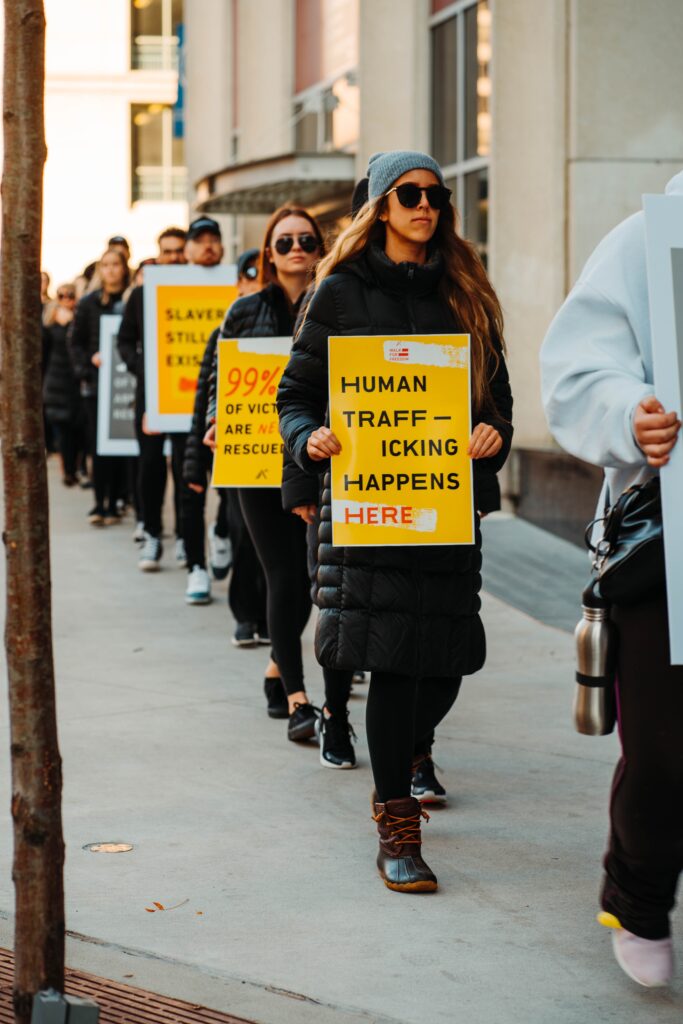Human trafficking is a largely hidden crime involving one or more people exploiting another person for labor, services, or commercial sex. The trafficker uses force or violence, fraud or false promises, or coercion and manipulation to lure victims and exploit them through physical, financial, or psychological means.
January is National Human Trafficking Prevention Month. This month is dedicated to raising awareness about different forms of human trafficking, ways to support trafficking survivors, and educating communities about these issues so that people are equipped to notice potential trafficking situations and report them to their local law enforcement.
According to UNODC, the crime of human trafficking consists of three core elements:
- The Act: a trafficker must recruit, transport, transfer, harbor, or receive
- The Mean: using methods of threat, use of force, coercion, fraud, deception, abuse of a position of power, giving payment or benefits, or abduction
- The Purpose: for exploitation
Worldwide, experts believe there are more situations of labor trafficking than of sex trafficking, but there is much wider awareness of sex trafficking in the U.S. than of labor trafficking.
There is no profile of a trafficked person – trafficking affects people from all economic classes, racial and ethnic identities, gender identities, and sexual orientations, and both adults and children can be trafficked. However, human trafficking disproportionately impacts Native American, BIPOC, and LGBTQIA+ communities.
50 million people are currently estimated to be victims of modern-day slavery, globally. You probably don’t see it, but this crime occurs every day in the United States. Here are some key facts and statistics on human trafficking in the U.S. 403,000 estimated individuals are being trafficked in the United States.


Someone may be in a trafficking situation if they:
- Seem distrustful of authorities.
- Are shadowed by someone who seems to be speaking for them and controlling their behavior.
- Have no passport or ID.
- Have limited personal belongings.
- Are wearing dirty, worn, or over-sexualized clothing.
- Are unable or unwilling to answer questions about their living situation or employment.
- Seem fearful or detached.
- Avoid eye contact.
- Appear malnourished or injured.
- Have a “branding” mark/tattoo/scar.
Of course, these situations do not immediately indicate that someone is being trafficked, but if you notice these things, it may be good to speak out.
It is a myth that traffickers target victims they do not know.
As people scroll through social media, they are likely to come across a story or warning about “suspicious” people hanging out in their local Walmart parking lot or gas station. While these are situations to be wary of, many cases of human trafficking do not involve a “masked, mystery person” kidnapping their victim. Social media feeds also fill up with terrifying stories of children being snatched off the streets by traffickers, packaged in shipping crates or auctioned off online and sold to the highest bidder. Sometimes these stories are spread by well-meaning people who are truly concerned. Other times, they are being put forward by organizations and individuals with other agendas.
Many survivors are trafficked by romantic partners, including spouses, and by family members, including parents. For example, if a husband forces his wife engage in sexual favors to his friends in exchange for money or another good, that is trafficking. Initial consent to commercial sex or a labor setting prior to acts of force, fraud, or coercion (or if the victim is a minor in a sex trafficking situation) is not relevant to the crime, nor is payment.
All commercial sex involving a minor is legally considered human trafficking. Commercial sex involving an adult is human trafficking if the person providing commercial sex is doing so against his or her will because of force, fraud, or coercion.
These cases don’t only happen in underground industries, either. Human trafficking cases have been reported and prosecuted in industries including restaurants, cleaning services, construction, factories and more.
Human trafficking is often confused with human smuggling, which involves illegal border crossings. In fact, the crime of human trafficking does not require any movement whatsoever. Survivors can be recruited and trafficked in their own hometowns, even their own homes.
Not everyone being trafficked is physically unable to leave their situation, either. More often people in trafficking situations stay for reasons that are more complicated. Some lack the necessities to physically get out – such as transportation or a safe place to live. Some are afraid for their safety. Some have been so effectively manipulated that they do not identify at that point as being under the control of another person.

Every trafficking situation is unique and self-identification as a trafficking victim or survivor happens along a continuum. Fear, isolation, guilt, shame, misplaced loyalty, and expert manipulation are among the many factors that may keep a person from seeking help or identifying as a victim even if they are, in fact, being actively trafficked.
Human trafficking as portrayed in Hollywood and popular media looks a lot like kidnapping. The reality is much more complicated. Recognizing potential red flags and knowing the indicators of human trafficking is a key step in identifying more victims and helping them find the assistance they need.
If you need any additional information, have a question, or a concern, feel free to reach out to Options at our 24-hour toll free helpline 800-794-4624. You can also reach an advocate via text by texting HOPE to 847411 or click 24-Hour Chat with Options.
Written by Anniston Weber


